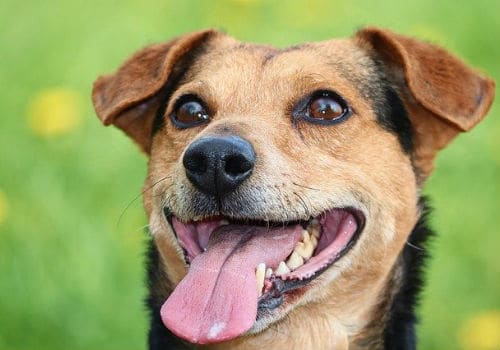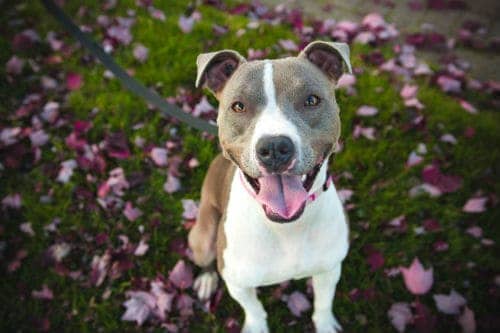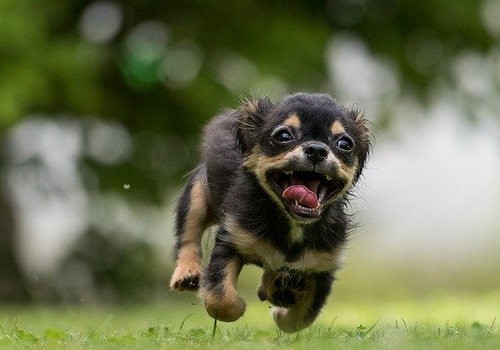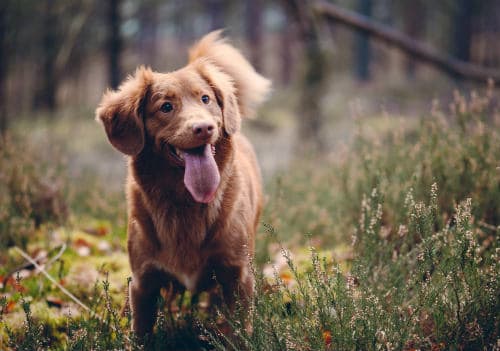Dogs have many signature behaviors: tail wagging, head tilting, butt sniffing and, of course, panting.
Usually, us humans only pant when we’re exhausted and need the extra airflow to help us catch our breath. But it seems like dogs pant for just about any reason — or for no reason at all.
Heavy, open-mouthed breathing in dogs is totally normal, but panting can also be a dog’s way of signaling that something is amiss. So what could be the problem… and how can you tell when panting is cause for concern?
Here are five reasons why dogs pant, plus some clues to help you figure out why your dog is panting. Take a deep breath, now — we’re about to dive in!
The Top 5 Reasons Why Dogs Pant
1. Dogs Pant to Cool Down

When we’re too warm, our bodies automatically respond by sweating.
It seems counterintuitive to shed moisture when you’re heating up, but it works. When air hits the sweat droplets, it has a much stronger cooling effect than if it hit your dry skin.
We’ve been blessed with sweat glands all over our bodies, with particularly high concentrations in our palms, armpits, groins, backs and foreheads. These glands provide us with a built-in full-body cooling system.
But dogs aren’t so lucky. They do have sweat glands, but they’re only found on the paw pads, and even then, they’re pretty sparse.
Rather than sweating, dogs cool down by panting. The basic principle is the same as sweating: when air hits the dog’s moist mouth and tongue, it cools more efficiently than when it hits the rest of the dog’s body.
Panting also allows the dog to expel hot body-temperature air from his lungs and exchange it for cooler air from the outside, The inside of the lungs is also moist, so the new, cool air chills the dog from the inside out.
However, panting to cool off just isn’t as efficient as sweating. That’s why dogs start panting as soon as it’s even slightly warm, whereas we don’t start sweating until it’s at least a few degrees hotter than we’d like.
Brachycephalic (short-snouted) dogs like pugs, French bulldogs and chow chows have it even worse. Since these dogs have shallower mouths, there’s less surface area inside to be cooled.
And since their airways are more restricted than long-snouted dogs, they need to work even harder to pant. That’s why these breeds are so susceptible to heatstroke and heat exhaustion.
But regardless of breed, panting stops working when air temperatures rise above 102 degrees Fahrenheit — a dog’s body temperature. When dogs inhale air that’s hotter than their bodies, the air heats them up rather than cooling them down.
If it’s warm outside and your dog is panting despite being idle, keep an eye out for signs like wide eyes, weakness and reddening tongue, and gums. These are all signs of serious overheating and may indicate a need for medical attention.
2. Dogs Pant When They’re Anxious

Ever felt anxious or highly stressed out before a big presentation or when entering new situations? If so, you probably noticed some physiological symptoms: shakiness, tense muscles and rapid breathing.
Dogs may not have job interviews or in-laws to meet, but they get anxious just like us. And their symptoms are actually very similar to ours, particularly the respiratory ones.
Anxious dogs are often mistaken for happy ones at first glance. Panting causes the mouth to open in a smile-like way.
But a more careful look reveals telling signs that panting is stress-related. Rigid posture, wide eyes, pinned-back ears, skittishness, trembling and whining can all indicate anxiety, especially when accompanied by panting.
Whether it’s a passing thunderstorm, an impending vet visit, or the appearance of the dreaded vacuum cleaner, the world is full of things that make your dog anxious. But lots of other, less expected triggers can provoke an anxiety attack: a noisy air conditioner, the sudden slam of a car door or loud footsteps from the upstairs neighbors.
To identify the source of your dog’s anxiety, try to view the world from his perspective. Look and listen closely, taking into account his ultra-sensitive nose and ears, and see if you notice anything different or disruptive.
Removing your dog from the situation should resolve the anxiety. But if it’s not possible to get rid of the anxiety-provoking stimuli, talk to your vet — medication could help your dog calm down in stressful situations.
3. Dogs Pant During Active Play

When you reach into the toybox and pull out your dog’s favorite tug-of-war rope, he may start panting and drooling uncontrollably. Panting may also start up as you pull into the parking lot at the dog park or approach the doggy daycare center.
And after a good roughhousing session with his favorite playmate, you’ll probably see that tongue lolling out and hear those rapid, heavy breaths.
In all of these scenarios, panting is a perfectly normal expression of excitement, both mental and physical. Play and exercise (and the anticipation of them) increase a dog’s heart rate, which in turn necessitates more oxygen, which leads to panting.
It’s important to monitor your dog during play for signs of heat exhaustion or injury, which can also cause panting. But under normal circumstances, panting before, during and after play is completely normal and a sign that your dog is thrilled to be active.
4. Dogs Pant Due to Pain, Discomfort or Injury
Ever tried to walk on an injured foot? It’s uncomfortable at best and excruciating at worst, but either way, you were probably breathing pretty hard after just a few steps.
Moving around when you’re in pain is simply exhausting. That goes for both us and our four-legged friends.
A dog with a sprained ankle may start panting after walking across the house, and one with a hip injury may pant while getting up and lying down. In these cases, panting is a sign that your dog’s body is trying to calm itself down from the stress of moving while in pain.
Unfortunately for us, dogs are pretty good at hiding their pain and discomfort from us. In fact, you may have no idea that your dog is hurt until you notice him panting for what seems like no reason.
If you notice that your dog’s panting is accompanied by avoidance of a certain limb, limping, lethargy, sensitivity to touch or hiding, pain could be to blame. It’s best to get him to a vet ASAP to see if he’s injured and if so, to get some medication for pain relief.
5. Dogs Pant Because They’re Sick

Many illnesses can cause your dog to become short of breath or feverish and overheated. Both of these symptoms can then cause panting, either to take in more oxygen or to cool the body down.
If your dog feels warmer than usual and is panting excessively despite normal air temperatures, he’s probably got a fever. Fevers can indicate many different conditions: viral infection, bacterial infection, poisoning or even a response to medication or vaccination.
More chronic health problems that can cause panting include Cushing’s disease, a condition in which the dog’s body produces excessive amounts of cortisol, also known as the stress hormone. This results in constant stress-like symptoms such as restlessness, increased thirst and hunger, weight gain and, yes, panting.
Panting may also precipitate a vomiting episode, which could be caused by overeating, GI tract infection, internal parasites or poisoning.
Heart disease can also induce heavy panting, as the lungs must work harder to keep up with the increased heart activity. Of particular concern is an enlarged heart, which can cause the lungs to fill with fluid and take in too little oxygen with each breath.
Any time your dog’s panting is accompanied by fever, weakness, appetite changes, vomiting or diarrhea, see a vet as soon as possible. When these symptoms are present, panting could indicate a serious illness that requires medical intervention.

I hurt and the hurt is from losing my good friend Baxter.
He was always there.